Through the Featured Chess Set project, the World Chess Hall of Fame showcases a variety of chess sets throughout the year. These include highlights from the institution’s collection as well as chess sets owned by Saint Louis metropolitan area friends and chess lovers who have special stories to accompany their sets.
Do you live in the Saint Louis metropolitan area and have a chess set with a great story? Submit it for inclusion in our Featured Chess Set project! This program highlights chess sets with interesting backgrounds borrowed from chess lovers and fans of the Hall of Fame. Featured chess sets are displayed for a period of one month at the World Chess Hall of Fame.
If you would like to participate in the program, send a photo and the story of the set to Emily Allred, Assistant Curator, at emily.allred@worldchesshof.org.
January
January's Featured Chess Set is on loan from Kyle Weber, a scholastic coordinator at the Saint Louis Chess Club. Weber, who has nearly a decade of experience in public education, public policy, curriculum, and instruction, has worked with the organization since September 2016. While he was teaching at University Academy in Kansas City, chess became a regular part of the school day both inside the mathematics classroom and as part of a robust 80 student after school chess program. Chess facilitated a need to connect with students on a personal level and address the holistic needs of their development. Weber is a father, husband, and educator.

Parker Brothers
Smess: The Ninny's Chess
1970
King size: 2 1⁄8 in.
Board: 17 3⁄4 x 17 3⁄4 in.
Plastic and cardboard
Collection of Kyle Weber
Players must protect their brains from ninnys and numskulls in Smess, a humorous variant on the game of chess. Perry Grant, a sitcom writer and producer who created scripts for over 35 shows including The Adventures of Ozzie and Harriet, Maude, The Jeffersons, Good Times, I Dream of Jeannie, The Odd Couple, and Happy Days, created the game. Smess replaces the familiar chess pieces with four numskulls, which can move any number of squares; seven ninnys, which may only move one square at a time; and one brain, which can move one square at a time. The objective of Smess is to capture your opponent’s brain. Pieces move around the colorful board according to the directions of the arrows on their starting spaces and may capture other pieces by landing on their squares. According to the box, which touts SMESS as a simpler alternative to chess, “the game can be played with skill—but it’s the NINNYs or the NUMSKULLS that capture the BRAIN.”
February
February’s Featured Chess Set is part of the collection of the World Chess Hall of Fame (WCHOF). Since its creation in 1986, the WCHOF has endeavored to highlight the history and cultural significance of the game of chess. The WCHOF’s collection is diverse and includes sets once owned by legendary players, mass-produced sets with lively pop culture themes, antique ivory sets, travel sets, as well as chess computers. Through these artifacts, the WCHOF illustrates how chess has evolved through its over 1500-year history. This set is part of a generous donation from the estate of Jacqueline Piatigorsky, a 2014 inductee to the U.S. Chess Hall of Fame.
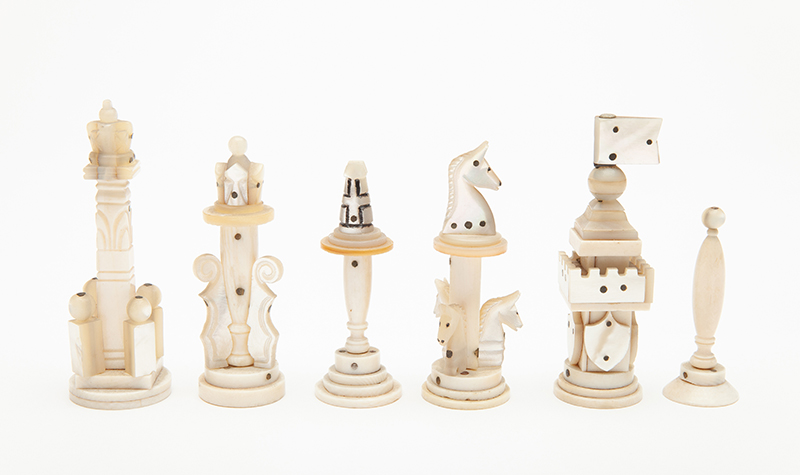
Mother of Pearl and Ivory Chess Set
20th Century
King size: 2 11⁄16 in.
Mother of pearl and ivory
Collection of the World Chess Hall of Fame, gift of the Jacqueline Piatigorsky Estate
Created from mother of pearl and ivory, this elegant chess set features playful variations of familiar pieces. The set once belonged to Jacqueline and Gregor Piatigorsky, a couple who shared a passion for music, art, and chess. A skilled chess player, Jacqueline earned second place in the 1965 U.S. Women’s Chess Championship. However, she earned greatest acclaim for her philanthropic chess activities as well as her sponsorship of the Piatigorsky Cup—one of the strongest tournaments held on American soil before the Sinquefield Cup, which is held annually in Saint Louis. Gregor was one of the most famous cellists of his era, and during his travels, he collected beautiful artistic chess sets that he displayed at the Piatigorskys’ Los Angeles, California, home.
March
March’s Featured Chess Set is from the collection of the World Chess Hall of Fame. Since its creation in 1986, the World Chess Hall of Fame (WCHOF) has endeavored to highlight the history and cultural significance of the game of chess. The WCHOF’s collection is diverse and includes sets once owned by legendary players, mass-produced sets with lively pop culture themes, antique ivory sets, travel sets, as well as chess computers. Through these artifacts, the WCHOF illustrates how chess has evolved through its over 1500-year history.
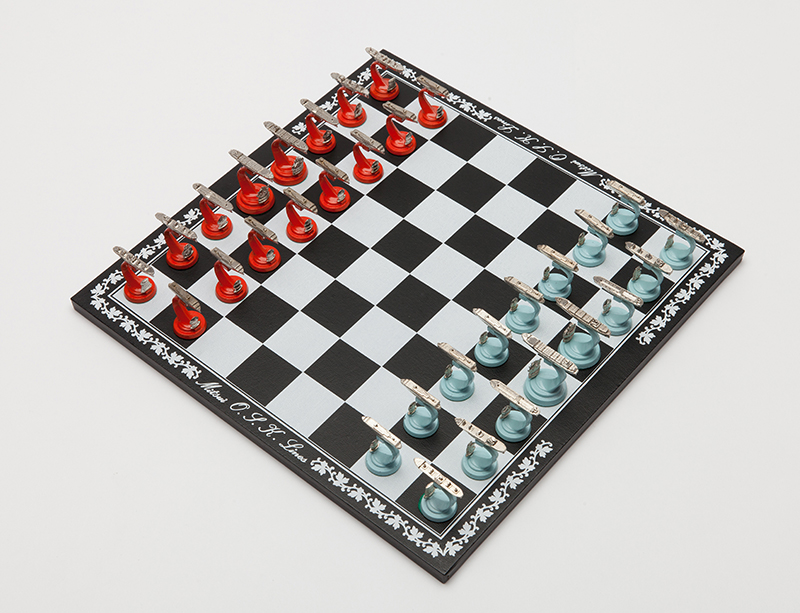
Mitsui O.S.K. Lines
Ocean Liner Chess Set
Date unknown
King size: 1 1⁄2 in.
Board: 5⁄16 x 11 13⁄16 x 11 13⁄16 in.
Die cast metal pieces and wood board
Collection of the World Chess Hall of Fame
Sleek silver ships sail atop stands that resemble waves in this promotional chess set from the collection of the World Chess Hall of Fame. Headquartered in Tokyo, Japan, Mitsui O.S.K. Lines is a Japanese transportation company. The company was formed through the merger of OSK Lines and Mitsui Steamship Co. in 1964. The pieces resemble their different types of cargo liners and each have a small representation of their piece on their base to aid players in differentiating the pieces.
April
April’s Featured Chess Set is from the collection of the World Chess Hall of Fame. Since its creation in 1986, the World Chess Hall of Fame (WCHOF) has endeavored to highlight the history and cultural significance of the game of chess. The WCHOF’s collection is diverse and includes sets once owned by legendary players, mass-produced sets with lively pop culture themes, antique ivory sets, travel sets, as well as chess computers. Through these artifacts, the WCHOF illustrates how chess has evolved through its over 1500-year history.

Terra Toys
Congo Basin Chess
2012
King size: 1 1⁄2 in.
Board: 15 x 15 in.
Wood and cardboard
Collection of the World Chess Hall of Fame
Photos of lions, hippopotamuses, rhinoceroses, elephants, and chimpanzees appear on the pieces for this set, which features a unique folding game board that is also a box. The set is named for the Congo Basin, an ecologically diverse region of Africa that includes portions of Cameroon, Central African Republic, Democratic Republic of the Congo, Republic of the Congo, Equatorial Guinea, and Gabon. A portion of sales from this set benefited the World Wildlife Fund. Established in 1961, the fund has the mission “to conserve nature and reduce the most pressing threats to the diversity of life on Earth.”
May
May’s Featured Chess Set is from the collection of the World Chess Hall of Fame (WCHOF) and was created by Yuko Suga for the exhibition Imagery of Chess: Saint Louis Artists, which was on view from March 23 to September 24, 2017. Suga studied metalsmithing with Heikki Seppa at Washington University in St. Louis, where she received an Intense Minor in Metals and a Master of Science degree in Occupational Therapy. She is involved in community-based programs as both a therapist and an artist, working with diverse groups of individuals in a variety of settings. Suga is a member of the faculty of the Craft Alliance Center of Art + Design. This set is on view in connection with the opening of the WCHOF’s newest exhibition, M.C. Escher: Infinite Variations, which has several works that include mirror images.

Yuko Suga
Image Re: In Glass
2017
Glass, wood, plastic, and acrylic
King size: 4 in.
Board: 19 x 17 ¼ x 21 ¼ in.
Collection of the World Chess Hall of Fame
Image Re: In Glass presents a chess set that, upon first glance, is literally one-sided. Progress in the game is constrained by the set’s form—16 pieces and half a board. In this work, Yuko Suga positions the viewer, whose own reflection is visible in the vanity mirror, as his or her own greatest competitor. Each piece is both white and black, with gradation between the two, and the board is made of mirrored squares. The spacing among them is flexible, and may be greater, smaller, angled, or even absent; however, to function as part of the chessboard, they must relate to one another. According to the artist, in order to develop into a community that is able to identify as “we,” there is a need for individual and community introspection as well as reflection.
June
June’s Featured Chess Set is from the collection of the World Chess Hall of Fame. Since its creation in 1986, the World Chess Hall of Fame (WCHOF) has endeavored to highlight the history and cultural significance of the game of chess. The WCHOF’s collection is diverse and includes sets once owned by legendary players, mass-produced sets with lively pop culture themes, antique ivory sets, travel sets, as well as chess computers. Through these artifacts, the WCHOF illustrates how chess has evolved through its over 1500-year history.
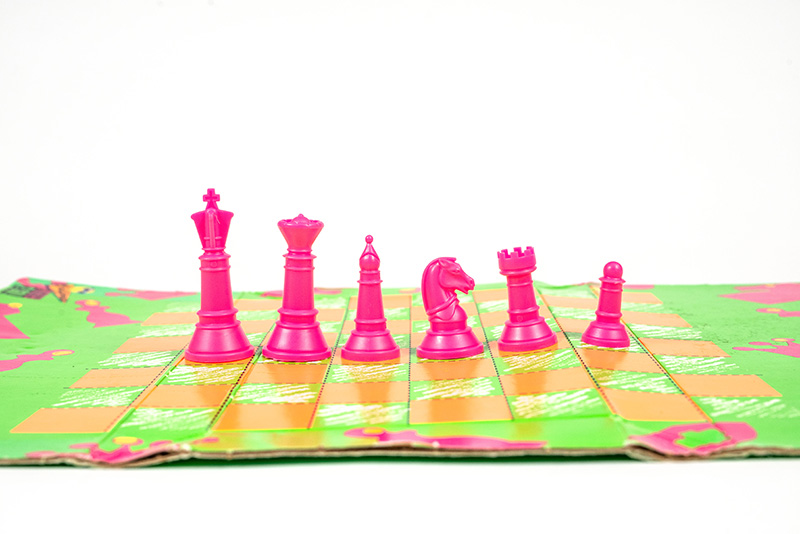
Mattel
California Classics 2 • Go! Chess, 1992
King size: 2 3⁄8 in.
Board: 17 1⁄8 x 12 ½ in.
Plastic and cardboard
Collection of the World Chess Hall of Fame, © Mattel
June’s Featured Set has been selected in connection with the opening of Golf the Galleries – Artist-Designed Mini Golf (June 1-August 11, 2019), an interactive art exhibition at the Sheldon Art Gallery that features a creative mini golf course with holes designed by artists, designers, and the World Chess Hall of Fame. The eye-catching colors and 90s’ aesthetic of this portable chess set provided the inspiration for Perpetual Check, the WCHOF’s submission to the exhibition. The chess set is part of a series of games—which included backgammon, checkers, dominoes, and chinese checkers—that were produced by Mattel in neon colors in 1992. The brightly-colored board can fold into a box used to hold the chess pieces.
July
July’s Featured Chess Set is from the collection of the World Chess Hall of Fame. Since its creation in 1986, the World Chess Hall of Fame (WCHOF) has endeavored to highlight the history and cultural significance of the game of chess. The WCHOF’s collection is diverse and includes sets once owned by legendary players, mass-produced sets with lively pop culture themes, antique ivory sets, travel sets, as well as chess computers. Through these artifacts, the WCHOF illustrates how chess has evolved through its over 1500-year history.

Fifth Avenue Crystal
Tropics Chess Set
Date unknown
King Size: 3 ⅛ in.
Board: 14 x 14 in.
Glass
Collection of the World Chess Hall of Fame
In this tropics-themed chess set, swordfish and dolphins reign as king and queen. Their courts include parrots as bishops, seahorses as knights, seashells as rooks, and fish as the pawns. Though the World Chess Hall of Fame’s collection contains many playing sets once owned or used by the game’s greatest players, it also includes many sets meant for display rather than play like this one, which is made of glass.
August
August’s Featured Chess Set is from the collection of the World Chess Hall of Fame. Since its creation in 1986, the World Chess Hall of Fame (WCHOF) has endeavored to highlight the history and cultural significance of the game of chess. The WCHOF’s collection is diverse and includes sets once owned by legendary players, mass-produced sets with lively pop culture themes, antique ivory sets, travel sets, as well as chess computers. This month’s featured chess set is part of a collection amassed by David Roderer, which is now part of the permanent collection of the World Chess Hall of Fame. Roderer obtained chess sets as gifts and while traveling around the world with his wife Nancy.
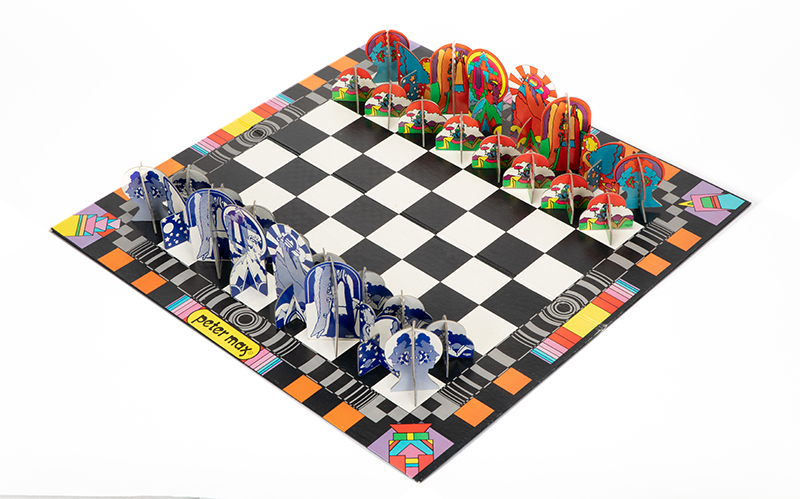
Kontrell
The Peter Max Chesset
1971
King size: 5 in.
Board: 23 7/8 x 24 in.
Cardboard
Collection of the World Chess Hall of Fame, gift of David Roderer
This cardboard chess set features the psychedelic art of graphic designer Peter Max. He rose to fame during the 1960s, when his colorful artwork appeared in advertisements and on magazine covers and posters. The Peter Max Chesset appeared in 1971, just one year before American grandmaster Bobby Fischer won the World Chess Championship. His victory led many periodicals to produce guides to buying chess sets for aspiring players. According to the New York Times’ article “Fischer Furor Sparks Big Run on Chess Sets,” the Peter Max set was a bestseller and sold for $10 (about $60 today).
September
September’s Featured Chess Set is part of the collection of the World Chess Hall of Fame (WCHOF). Since its creation in 1986, the WCHOF has endeavored to highlight the history and cultural significance of the game of chess. The WCHOF’s collection is diverse and includes sets once owned by legendary players, mass-produced sets with lively pop culture themes, antique ivory sets, travel sets, as well as chess computers. Through these artifacts, the WCHOF illustrates how chess has evolved through its over 1500-year history. This set is part of a generous donation from the estate of Jacqueline Piatigorsky, a 2014 inductee to the U.S. Chess Hall of Fame.

Joahann Joachim Kändler for Meissen
Meissen Chess Set
1748
King size: 3 7⁄8 in.
Board: 12 5⁄8 x 12 5⁄8 in.
Porcelain
Collection of the World Chess Hall of Fame, gift of the family of Jacqueline Piatigorsky
This elegant porcelain chess set, which is paired with a board adorned with flowers, is one of the oldest objects in the collection of the World Chess Hall of Fame. The Meissen factory, the first producer of porcelain in Europe, created the set. Joahann Joachim Kändler, one of the factory’s most acclaimed modelers, designed it. Kändler was a court sculptor for the Elector of Saxony and Meissen founder, Frederick Augustus I. He became the chief modeler at Meissen in 1733, and he was influential in creating the tradition of making porcelain figurines. This set, which is missing one green knight, is set up in a position from a 1955 U.S. Women’s Chess Championship game between Mona May Karff and Jacqueline Piatigorsky. Piatigorsky won the brilliancy prize for this game.
October
October’s Featured Chess Set is from the collection of the World Chess Hall of Fame. Since its creation in 1986, the World Chess Hall of Fame (WCHOF) has endeavored to highlight the history and cultural significance of the game of chess. The WCHOF’s collection is diverse and includes sets once owned by legendary players, mass-produced sets with lively pop culture themes, antique ivory sets, travel sets, as well as chess computers. This month’s featured chess set became part of the WCHOF’s collection in 2018.

Sammy Palmer
Pumpkin vs. Ghost Chess Set
2018
King size: Ghost: 1 ½ in.; Pumpkin: 1 ⅜ in.
Stonecast, acrylic paint, and varnish
Collection of the World Chess Hall of Fame
Spooky ghosts and grinning jack-o’-lanterns face off in this whimsical Halloween-themed chess set. Sammy Palmer, a disabled artist living and working in the southern coast of England, created the set. Palmer, who is self-taught, has produced many chess sets featuring creative themes, including cows vs. sheep, cats vs. dogs, and Santa vs. snowmen. Palmer first made this one as a fun set for her family to play with. Family also provides inspiration for her other sets' themes, which often feature her children's favorite animals. Palmer's chess sets, jewelry, and gifts are available exclusively through HandmadebyDragon on Etsy.
November
November’s Featured Chess Set is part of the collection of the World Chess Hall of Fame (WCHOF). Since its creation in 1986, the WCHOF has endeavored to highlight the history and cultural significance of the game of chess. The WCHOF’s collection is diverse and includes sets once owned by legendary players, mass-produced sets with lively pop culture themes, antique ivory sets, travel sets, as well as chess computers. Through these artifacts, the WCHOF illustrates how chess has evolved through its over 1500-year history.
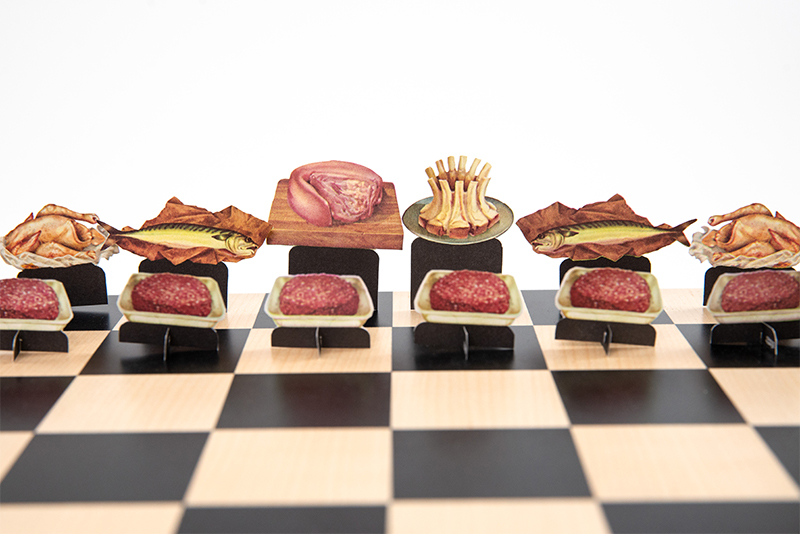
Writers: Anne Beatts and Michael O’Donoghue
Artist: Charles White III
Checkmeat, Fish, and Poultry Chef Set
1972
King size: Raw: 2 in., Cooked: 2 ⅜ in.
Paper
Collection of the World Chess Hall of Fame
The familiar white and black sides of a chess set are reimagined as raw and cooked meat in this set that appeared in the November 1972 issue of National Lampoon magazine. The set was printed on heavy paper, allowing readers to cut it out and assemble the pieces, and the article that accompanied the set suggested using a tablecloth or customized butcher board as the chessboard. Michael O’Donoghue and Anne Beatts, two early writers for Saturday Night Live conceived of the set.
December’s Featured Chess Set is part of the collection of the World Chess Hall of Fame (WCHOF). Since its creation in 1986, the WCHOF has endeavored to highlight the history and cultural significance of the game of chess. The WCHOF’s collection is diverse and includes sets once owned by legendary players, mass-produced sets with lively pop culture themes, antique ivory sets, travel sets, as well as chess computers. Through these artifacts, the WCHOF illustrates how chess has evolved through its over 1500-year history.

USAopoly, Inc.
Tim Burton’s The Nightmare Before Christmas Collector’s Chess Set
2018
King size: Jack Skellington: 2 ¾ in., Oogie Boogie: 2 ¾ in.
Plastic and cardboard
Collection of the World Chess Hall of Fame
White Pieces
King: Jack Skellington
Queen: Sally
Bishops: Happy and Sad Mayor
Knights: Zero
Rooks: Jack’s House
Pawns: Pumpkins
Green Pieces
King: Oogie Boogie
Queen: Shock
Bishops: Lock and Barrel
Knights: Bathtub
Rooks: Lock, Shock, and Barrel’s Treehouse
Pawns: Dice with snake
Jack Skellington and his friends face off against the villainous Oogie Boogie in this chess set based upon the 1993 musical film The Nightmare Before Christmas. The movie was directed by Henry Selick, produced by Tim Burton and Denise Di Novi, and featured music by Danny Elfman. In The Nightmare Before Christmas, Jack Skellington, the leader of Halloween Town, stumbles into a portal to Christmas Town. He becomes enchanted with the holiday, and seeks to have the denizens of Halloween Town take over its traditions, kidnapping Santa Claus in the process. The story is told through stop motion animation inspired by that of the classic Rankin/Bass Christmas specials like Rudolph the Red-Nosed Reindeer (1964) and Santa Claus Is Comin’ to Town (1970).
Check back next year for more featured chess sets!
-
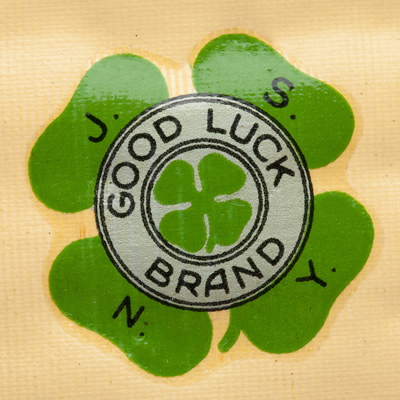
Special Project
January 1, 2018 - December 31, 2018
Read More

Special Project
January 1, 2017 - December 31, 2017
Read More
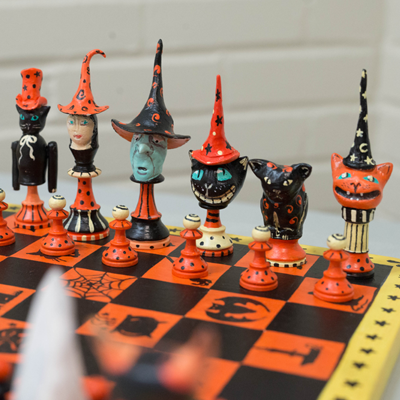
Special Project
January 1, 2016 - December 31, 2016
Read More















